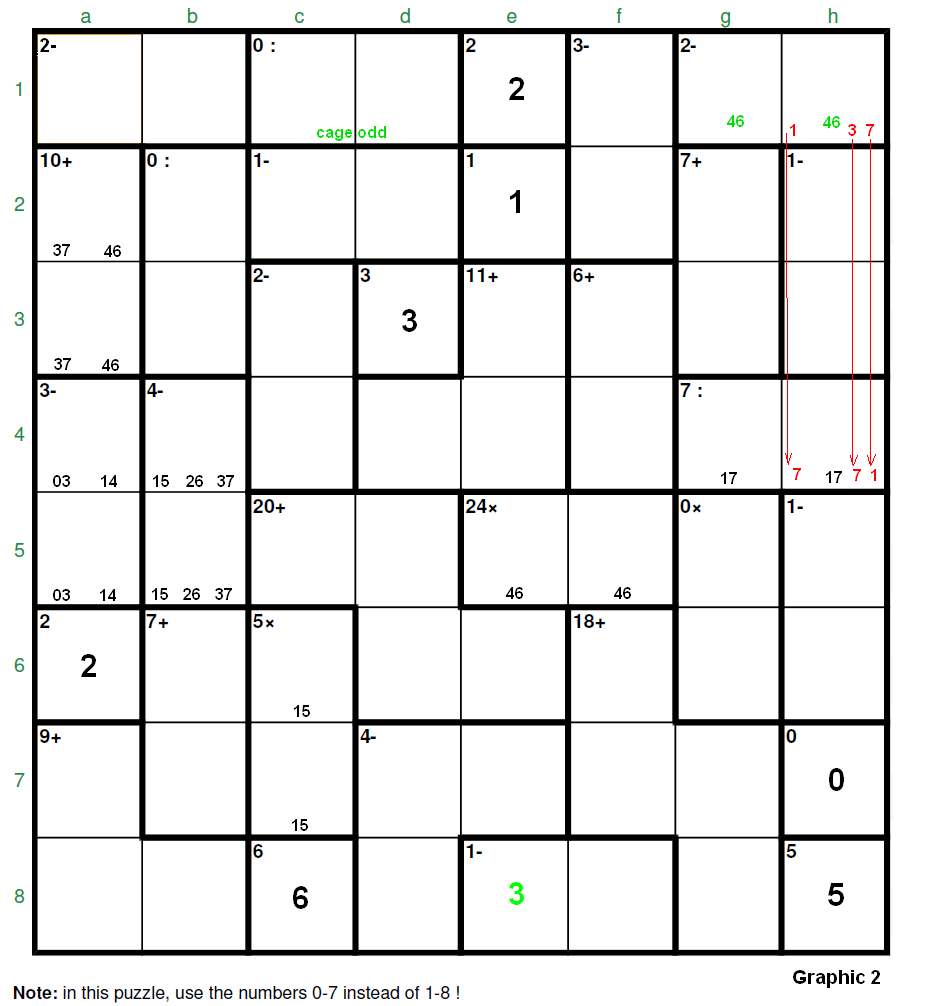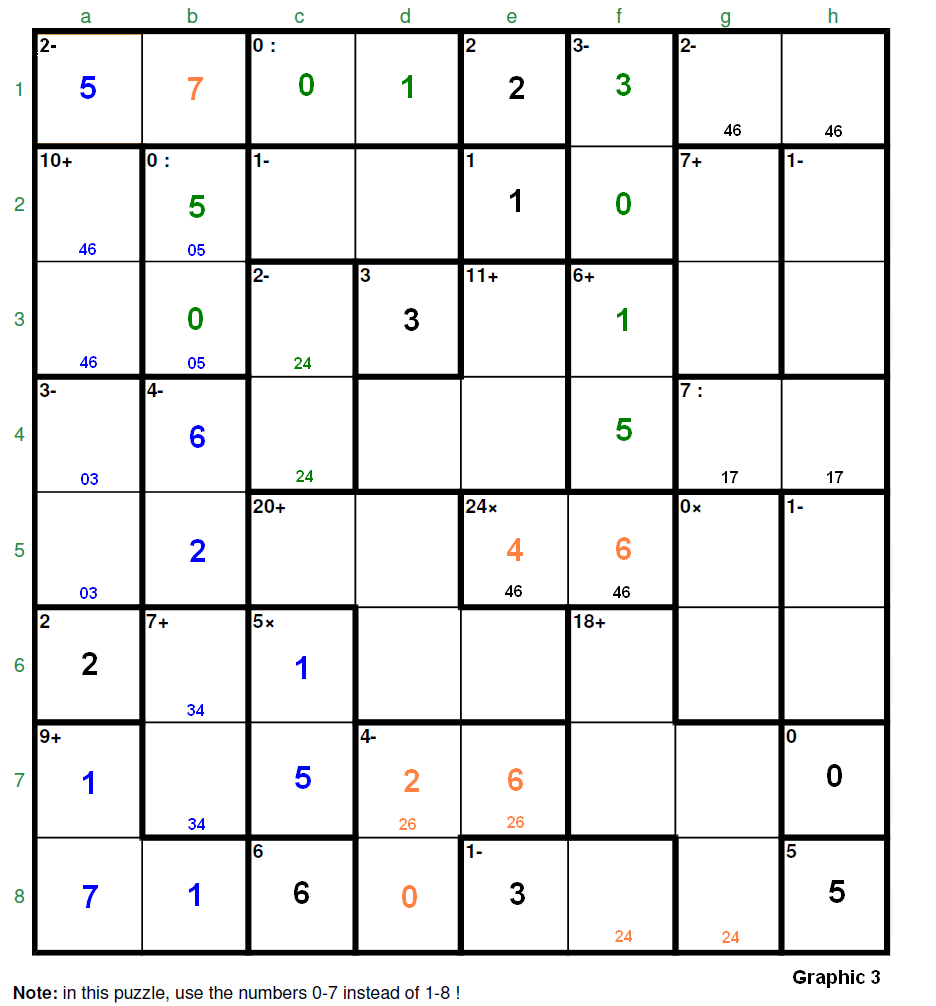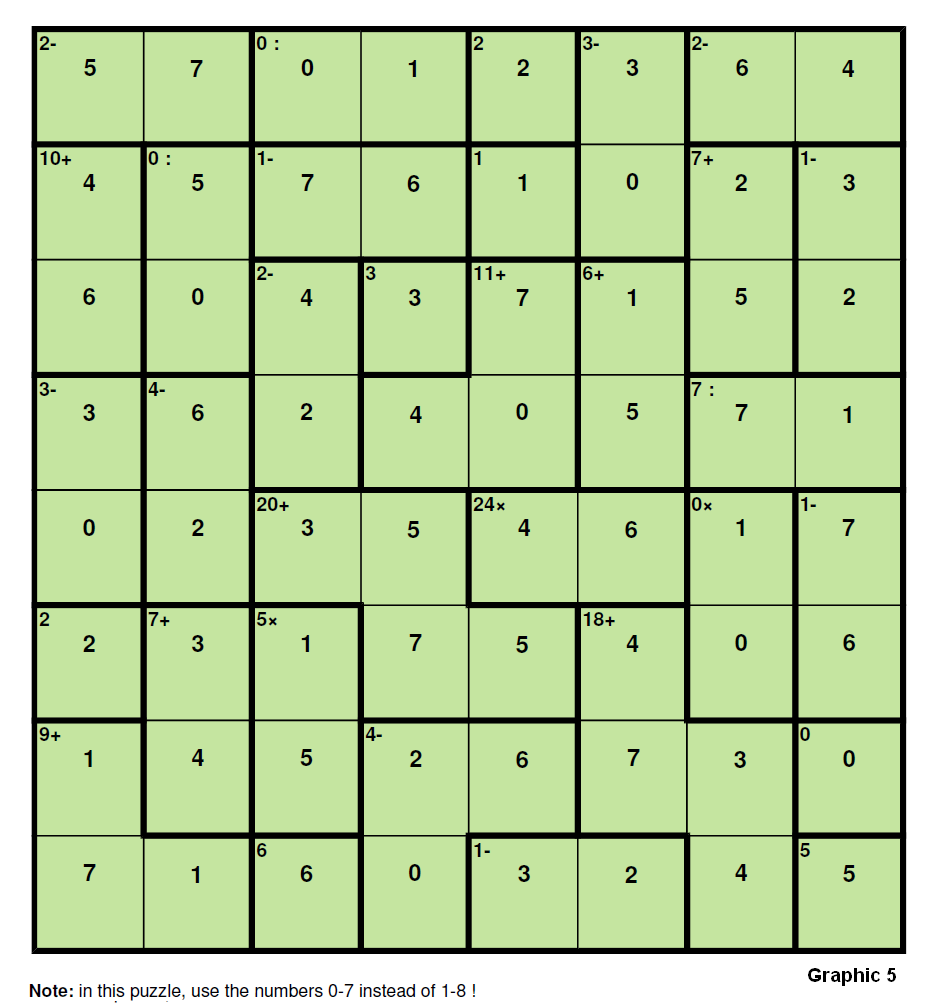Step by step: Analyzing an 8x8 “difficult” with zeros. The presence of zeros in a puzzle, cages of the type “0x” or “0:” or, simply, the “strange” fact that, i.e., in a 3-cell L-shape cage “0-” we may have a zero and two equal numbers like [0,3,3] does not represent a problem for advanced puzzlers. However, some “medium” players and most beginners do not usually like these type of puzzles, though these calcudokus are challenging and amused due to the possibility of having “any number” in the cages “0x” or “0:”; in the other hand, at least one zero is mandatory in both types of cages but
no more than one zero in cages of the type “0:” (this additional restriction due to the arithmetical uncertainty of the division operation).
The “addition rule” can be applied as normally considering that the sum of a line is 28 (for an 8x8 puzzle, that is, 0 + 1 + … + 7) instead of 36 (1 + 2 + … + 8). The “parity rule” (the 0 is an even number) can also be applied and useful as we will see inmediately. However, the “multiplication rule”, for instance, is not useful at all since the product of numbers in any line equals 0.
In the following example, the steps 2 and 3 are the
clue to solve the full puzzle, once we determine, using the parity rule, the value of the cell
e8 (=3). Our purpose is to only use the analysis avoiding the TAE (trial and error). Here is the problem (graphic 1, May 19, 2012, rating 79.2, 80 solvers):

Step 1: First of all, as usual, we place the known numbers and some pairs of candidates (graphic 2). The cage “10+” has only two possibilities: [3,7] and [4,6]; the cage “3-” (a4-a5) has only two possibilities: [0,3] and [1,4] since [3,6] or [4,7] are invalid because they would make impossible any of those two combinations for the cage “10+”. The cage “4-” (b4-b5) has initially three possibilities: [1,5], [2,6] and [3,7], with the [0,4] obviously forbidden due to the presence of a 0 in the cage “0:” (b2-b3).

Step 2: Let’s observe the cell h1: 0, 2 and 5 are not possible (they already exist in row 1 or column h); we are going to see that 1, 3 and 7 are invalid two, so we are left with 4 or 6 (and respectively, 6 or 4 in g1) thus producing for the cage “2-” (g1-h1) the pair of candidates
[4,6] (in green colour). The reason why (shown in red colour) the 1 or the 7 are invalid is because they force, respectively, a 7 or a 1 in h4 and consequently it would be impossible to place a 6 in any of the cages “1-” of column h (due to h8 = 5). Additionally if we had a 3 in h1 since a 2 should go to any of the cages “1-” in column h it would go with a 1 forcing again a 7 in h4 and then a 6 would not have a place in the alternate cage “1-”.
Step 3: Now we know that the cage “0:” (c1-d1) is an odd cage (a zero and an odd number, since the 2, 4 and 6 are present in row 1) and we can apply the parity rule to the three columns c, d and e (which total sum is 3 x 28 = 84 = even). Since e5 is even (4 or 6) we arrive at the conclusion that e8 must be odd and
the only possibility is a 3 (e2 = 1, h8 = 5 and clearly a 7 is not possible due to the 6 in c8).
Step 4: The previous result is important because now “10+” must be [4,6]. Let’s see why: a1 <> 6 (we have determined [4,6] in g1-h1); a7 <> 6 because a7 = 6 >>> b8 = 2, a8 = 1 (unique) >>> “3-” (a4-a5) = [0,3] and the cage “10+” becomes again impossible.
Graphic 3, blue colour: Once we have “10+” = [4,6] >>> “3-” (a4-a5) = [0,3]. The 5 (in column a) must go to a1 (a7 = 5 would require [0,4] or [1,3] in a8-b8, both invalid). Finally “9+” must be [1,1,7] as represented in the L-shape. See that now “4-” (b4-b5) can not be [1,5] or [3,7], this last one because b1 must be either a 3 or a 7 to complete the cage “2-” (a1-b1), so “4-” = [2,6] with b4 = 6, b5 = 2 (due to cage “24x”). As a consequence, ”7+” (b6-b7) = [3,4] and obviously b1 = 7 (this shown in brown colour) and “0:” (b2-b3) = [0,5]. Also a7 = 1 forces c6 =1, c7 = 5.

Step 5 (Graphic 3, brown colour): The 0 of row 8 can not be in g8 because there is a 0 in the cage “0x” (g5-g6) so d8 = 0 and f8-g8 = [2,4].
To complete the cage “4-” (d7-d8-e7), since the pairs [0,4], [1,5] or [3,7] are not possible (this last one because of the 3’s in d3 and e8), we are left with [2,6] then d7 = 2, e7 = 6 (due to e1 = 2). Logically e7 = 6 >>> e5 = 4 and f5 = 6 defining the positions in “24x”.
Step 6 (Graphic 3, in dark green colour): The cage “6+” must be [1,5] being [0,6] or [2,4] invalid, this last due to the fact that f8 must be either a 2 or a 4. Then f3 = 1, f4 = 5 (there is a 1 in “7:”). The 1 of row 1 must go to d1 (due to c6 = 1 and f3 = 1) with c1 = 0. And, consequently, f1 = 3, f2 = 0. This 0 produces b2 = 5, b3 = 0. Finally, we can write the pair of candidates for “2-” (c3-c4 ) = [2,4] (unique).

Step 7 (Graphic 4, light green colour): In column f, the 2 must go to f8 (due to a6 =2 and d7 = 2). As a consequence, g8 = 4 and f6-f7 = [4,7] (the pending numbers in column f). Now, in cage “18+”: g7 = 18 - 4 - 7 - 4 = 3 and this produces b7 = 4 and b6 = 3. And b7 = 4 >>> f7 = 7 >>> f6 = 4.
Step 8 (Graphic 4, purple colour): Since d3 = 3 and e8 = 3, the 3 of row 4 must go to a4 >>> a5 = 0 >>> g6 = 0 >>> e4 = 0 (the only place for a 0 in column e).
Step 9 (Graphic 4, violet colour): The cage “7+” (g2-g3), since the combinations [0,7], [1,6] (1’s in e2 and f3) and [3,4] are not possible, must be [2,5] and then g3 = 5, g2 = 2. This 5 in g3 forces the 5 of column e to go to e6 and e3 = 7 (left number in column e). Two consequences: d5 = 5 (the only position for a 5 in column d) and, in cage “11+”, d4 = 11 - 7 - 0 = 4. This 4 makes c4 = 2 >>> c3 = 4 >>> a3 = 6 >>> a2 = 4.
Step 10. If we now observe row 5, since a 3 is not valid in h5 (because the cage “1-” (h5-h6) could not be done due to a6 = 2, f6 = 4) and there is a 3 in g7, it follows that c5 = 3 (in brown colour) >>> c2 = 7 (left number in column c) >>> d2 = 6.
Step 11 (Graphic 4, light blue colour): For instance (in the final phases of the solution the sequence to complete the puzzle is not generally relevant), h6 = 6 (the 6 for row 6, d2 = 6 inhibits a 6 in d6) >>> h5 = 7 (there is a 5 in d5). Also h3 = 2 with h2 = 3 complete the rows 2 and 3.
The rest is trivial.
The official solution:





